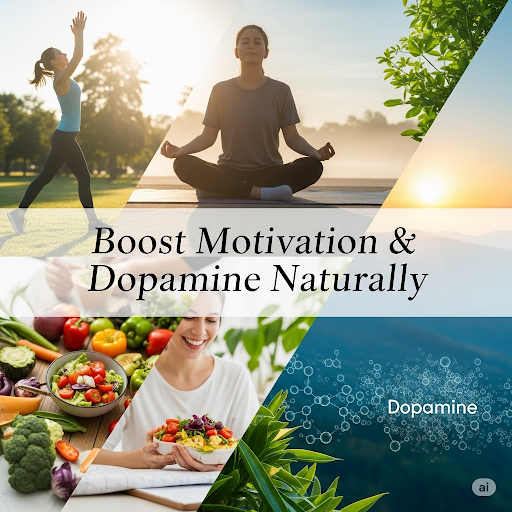No pills, no hacks just real strategies that actually work
Introduction: The Science (and Struggle) of Motivation
We’ve all been there staring at a to-do list like it’s written in ancient Greek, knowing exactly what we need to do… but doing absolutely none of it. Whether it’s cleaning the house, starting a workout routine, writing that paper, or just getting out of bed on a gray morning, motivation can feel maddeningly elusive.
Here’s the thing: it’s not always about laziness or discipline. Often, it comes down to chemistry specifically, dopamine, the neurotransmitter that acts like the “go” signal in your brain. Dopamine is what gives you that spark, that sense of drive, pleasure, reward, and satisfaction when you accomplish something. It’s the molecule behind every “aha!” moment, every task completed, every goal chased. In short, it’s the fuel behind motivation.
But modern life does a real number on our dopamine systems. Constant overstimulation from social media, processed foods, stress, poor sleep, and even boredom can dull our brain’s ability to feel naturally motivated. The good news? You can reboot your dopamine system. Naturally. No synthetic stimulants or overhyped hacks just proven, science-backed, and sustainable habits that gently nudge your brain back into drive mode.
Let’s explore how to wake up your inner go-getter by naturally boosting dopamine and reclaiming your motivation one habit at a time.
1. Get Moving: Exercise Is Dopamine’s Favorite Thing
You knew this was coming. Yes, exercise. But hear me out it’s not just for abs and Instagram likes. Physical activity is one of the most powerful natural ways to boost dopamine levels. It doesn’t have to be an intense HIIT session, either. Just 20–30 minutes of movement walking, dancing, biking, yoga, swimming can increase dopamine receptor sensitivity and production.
When you exercise, your brain releases a cocktail of feel-good chemicals, including dopamine, serotonin, and endorphins. That’s why people often report a “runner’s high” or post-workout clarity. But unlike a quick sugar hit, this dopamine release doesn’t leave you crashing. Instead, regular movement helps rewire your brain for sustained motivation and emotional resilience.
Want a simple hack? Combine music with exercise. Music also stimulates dopamine release, and together, they create a reward-rich experience that your brain learns to crave.
2. Fix Your Sleep, Fix Your Drive
You can’t talk about dopamine without talking about sleep. Your brain’s dopamine production is deeply tied to your circadian rhythm meaning, if your sleep is off, your motivation will be, too.
In fact, studies show that sleep deprivation reduces the availability of dopamine receptors in the brain. Less dopamine = less motivation, focus, and joy.
So what can you do? Aim for 7–9 hours of consistent, high-quality sleep per night. Try to keep your sleep and wake times consistent, limit screen exposure before bed (blue light suppresses melatonin), and create a dark, cool, quiet sleep environment.
Even one night of proper sleep can significantly improve dopamine function and restore your brain’s natural reward pathways. Your pillow might be the best productivity tool you never knew you had.
3. Upgrade Your Diet: Fuel Your Brain to Fire You Up
Your brain doesn’t run on fumes it runs on nutrients. And certain vitamins, minerals, and amino acids are directly involved in dopamine production.
Here are a few key players:
- Tyrosine: An amino acid found in eggs, chicken, turkey, cheese, tofu, and legumes. It’s the building block of dopamine.
- Vitamin B6, B9 (folate), and B12: These B-complex vitamins help convert tyrosine into dopamine. You’ll find them in leafy greens, beans, eggs, and whole grains.
- Magnesium: Supports dopamine receptor function. Found in nuts, seeds, dark chocolate, and avocados.
- Iron and Zinc: Needed for dopamine synthesis. Think red meat, shellfish, pumpkin seeds, and lentils.
Ditch the ultra-processed junk, which hijacks your dopamine system with quick spikes and crashes. Instead, focus on whole, colorful, nutrient-dense foods that fuel not just your body, but your motivation center too.
And don’t forget probiotics a healthy gut microbiome plays a surprisingly big role in neurotransmitter health. Fermented foods like yogurt, kimchi, and kefir can all help nurture that gut-brain connection.
4. Cold Showers, Sunlight & Nature: Rewire with the Elements
There’s something primal and powerful about reconnecting with the elements sunlight, fresh air, and even a bracing cold shower. These aren’t just “feel-good” practices; they stimulate real, biochemical changes in the brain.
- Cold exposure, like a cold shower or a plunge, triggers a significant spike in dopamine sometimes up to 250% according to some studies. The effect can last hours after the exposure. It’s uncomfortable at first, but that rush you feel afterward? That’s your dopamine kicking in.
- Sunlight exposure (particularly morning light) helps regulate your circadian rhythm and increases dopamine production via retinal stimulation. Spend at least 10–15 minutes outside after waking, preferably with natural light hitting your eyes (no sunglasses).
- Spending time in nature also reduces cortisol (stress hormone) and boosts dopamine and serotonin. Whether it’s a forest, a park, or just your backyard, getting outside is like a free brain reset.
These natural stimulants don’t deplete your dopamine they help your brain build more of it, making you more motivated over time.
5. Set Micro-Goals & Celebrate Wins (Yes, Even the Tiny Ones)
Here’s the psychology twist: dopamine isn’t just released when you achieve a goal it spikes when you anticipate a reward. That’s why breaking big tasks into micro-goals and checking off each one gives you those little surges of satisfaction that keep you going.
Instead of saying, “I’m going to write a book,” start with “I’ll write 100 words today.” Instead of “I need to lose 20 pounds,” say, “I’ll take a 15-minute walk this afternoon.”
Then here’s the key celebrate. Not with cookies or shopping sprees (though we won’t judge), but with a fist pump, a happy dance, a verbal “nailed it!” Dopamine is released in response to achievement and acknowledgment. The more you recognize your wins, the more your brain builds motivation loops. It’s like giving your brain a high-five every time you show up.
6. Practice Dopamine Fasting (and Win Back Your Focus)
You don’t need more dopamine hits you need healthier ones. The modern world bombards us with quick, artificial dopamine triggers: social media, junk food, video games, constant scrolling. These short-circuit the brain’s reward system, making real-life activities feel… boring.
Enter dopamine fasting the practice of temporarily cutting out overstimulating behaviors to reset your brain’s reward system. No, it doesn’t mean giving up dopamine. It means reducing instant gratification so your brain can start finding joy in real things again.
Try a few hours, or even a whole day, without screens, sugar, noise, or multitasking. Go for a walk without your phone. Read a book. Sit in silence. Meditate. Breathe. It’s weirdly hard at first but then clarity returns. And when you do something simple, like clean your room or cook a meal, it suddenly feels satisfying again.
That’s your dopamine system recalibrating.
7. Listen to Music, Learn Something New, and Get Curious
Music isn’t just background noise. It’s medicine for your motivation. Listening to music you love triggers the release of dopamine especially when the beat drops or the melody shifts unexpectedly. It’s pleasure, pure and simple. So crank up your favorite playlist when you’re cleaning, working, or exercising. Bonus points if you sing along.
Learning something new also boosts dopamine by engaging your brain’s reward system. Whether it’s learning a language, mastering a recipe, or finally figuring out how to change a tire, novelty and progress naturally increase motivation. Curiosity isn’t just fun it’s biochemical.
Even reading this article? Yep, that’s a dopamine drip too.
8. Meditate to Balance Dopamine and Calm the Noise
You might not associate stillness with motivation, but hear this: chronic stress, anxiety, and information overload drain your dopamine faster than a leaky faucet. That’s where mindfulness comes in.
Meditation has been shown to balance dopamine by calming the nervous system, improving focus, and enhancing mood. It doesn’t need to be complicated just five to ten minutes of mindful breathing, gratitude journaling, or simply sitting in silence can help rebalance your brain chemistry.
In a distracted world, meditation teaches your brain to slow down, zoom in, and find reward in the moment not just in the next notification.
Final Takeaway: You’re Wired for Motivation You Just Have to Spark It
Motivation isn’t about waiting for a lightning bolt. It’s about creating the conditions that allow your brain to come alive day after day, task after task. And dopamine? That’s the spark.
By moving your body, fueling your brain with the right nutrients, sleeping deeply, connecting with nature, and learning to celebrate even your smallest wins, you can gently rebuild your motivation circuitry from the ground up. No hype. No gimmicks. Just nature, science, and your own incredible biology doing its thing.
You were never lazy. You were just out of sync. But with a few daily shifts, you can light that fire again and this time, let it burn steady.











